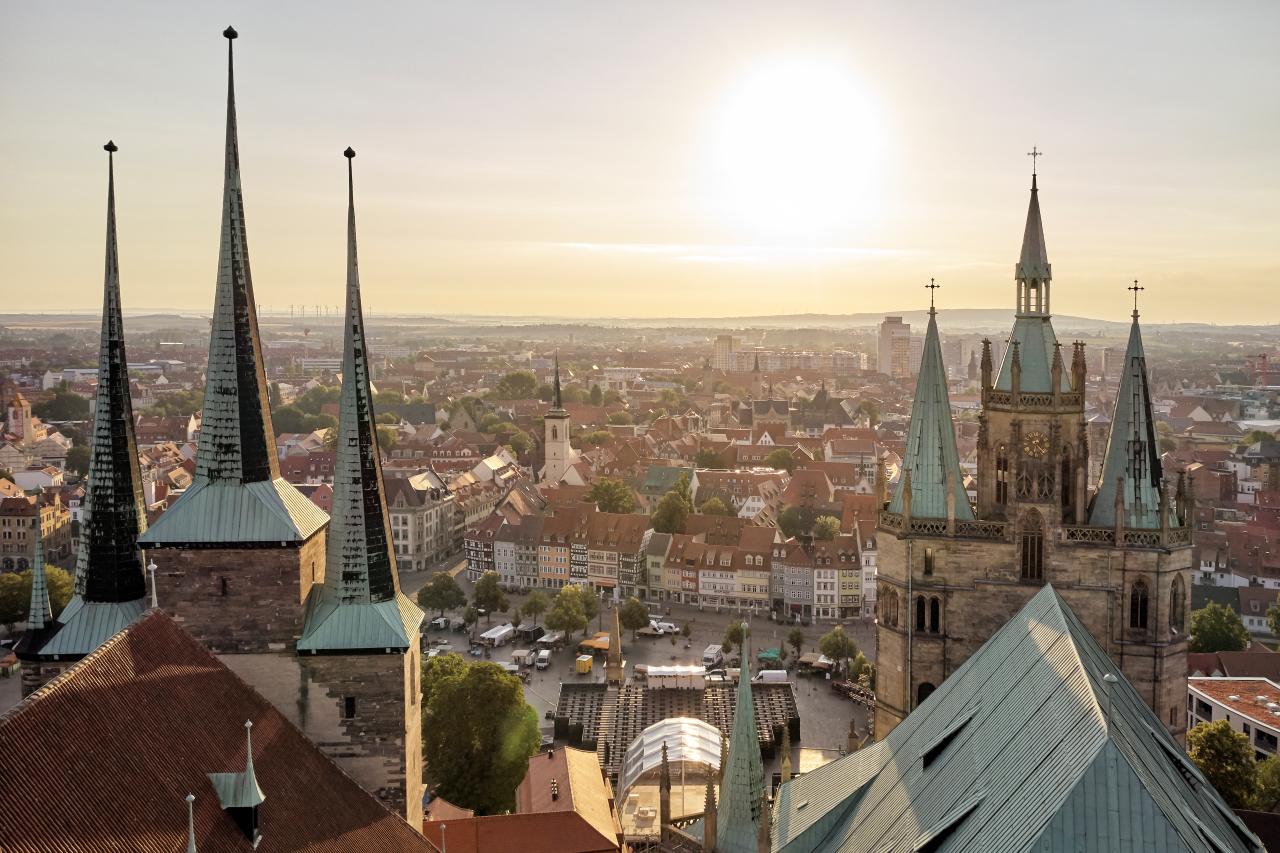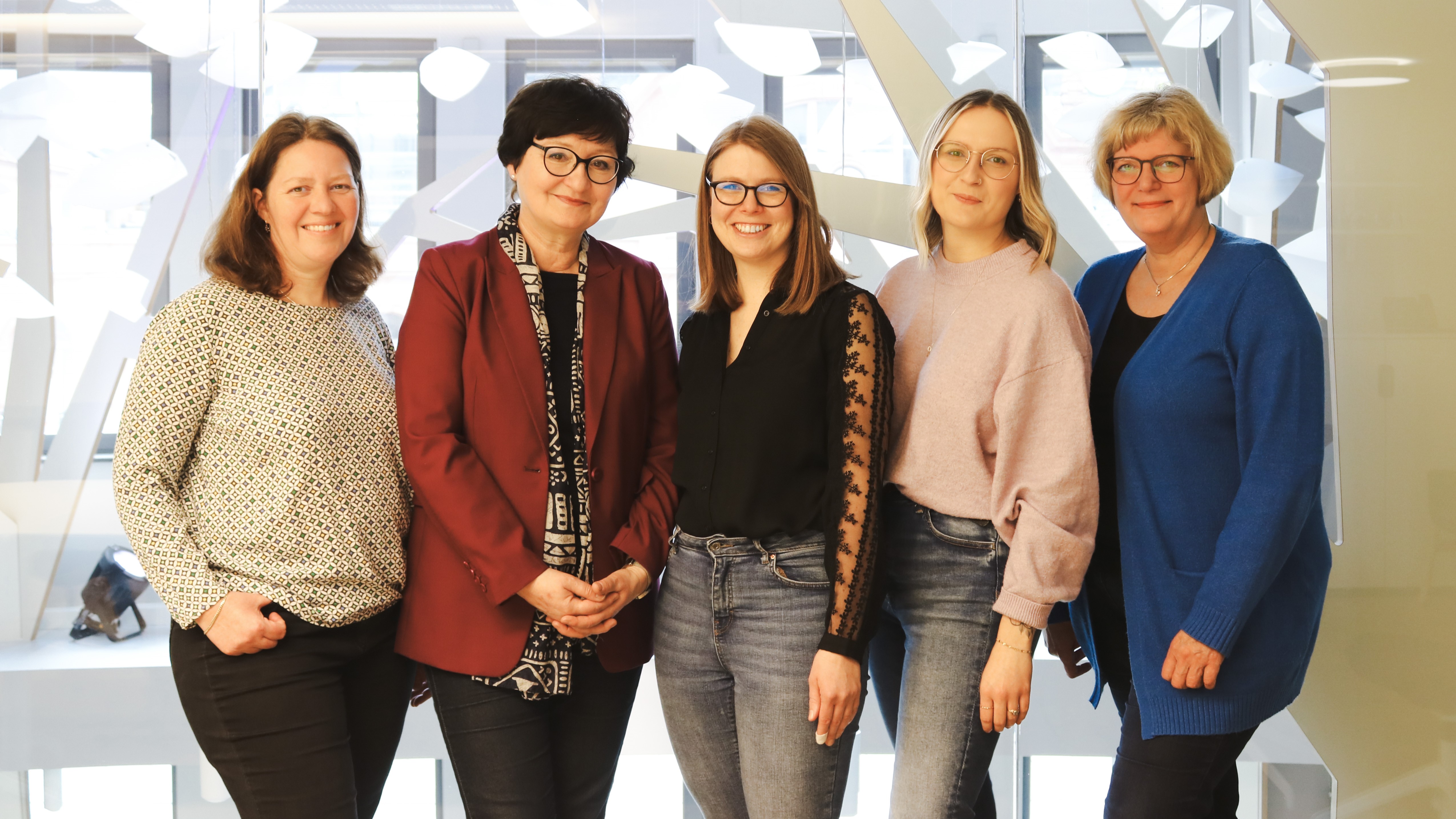Finden Sie Ihre Ansprechpartnerinnen für alles, was mit Thüringer Auslandsmarketing und B2B-Themen zu tun hat. Hier!
Museum St. Marien und Müntzergedenkstätte
Gotische Bühne für mittelalterliche Prominenz
Von französischen Kathedralen inspiriert, aus heimischem Stein erschaffen: Eingebettet zwischen denkmalgeschützten Häusern liegt in Mühlhausens Altstadt die imposante Marienkirche. Sie ist die zweitgrößte Kirche Thüringens und die größte fünfschiffige im Bundesland. Heute wird das entsakralisierte Gotteshaus als Museum St. Marien für Ausstellungen und als Müntzergedenkstätte genutzt. Die Errichtung des gotischen Meisterwerks begann im 14. Jahrhundert. Verwendet wurde Travertin, der helle Kalkstein der Region, zum Teil in Mühlhausen selbst abgetragen. Unverkennbar sind die Einflüsse der französischen Kathedralbaukunst – trotz der Überreste der romanischen Vorgängerkirche, die bei einem der Türme im unteren Bereich noch zu erblicken sind.
Prominente Schirmherrschaft
Das Museum St. Marien im Hauptteil der vormaligen Kirche beherbergt aktuell eine Sonderausstellung mit über 60 Objekten spätmittelalterlicher Kunst aus Thüringen, Sachsen und Franken – allesamt Leihgaben der Klassik Stiftung Weimar. Sie umfasst außergewöhnliche Altäre, Skulpturen, bunte Glasfenster mit Motiven von Christus, Maria und weiteren christlichen Heiligen. Typisch für diese Epoche: An vielen Stellen tauchen Einhörner und Drachen im Bildgefüge auf. Haben Sie beim Betrachten ein besonderes Gefühl? Vielleicht liegt das daran, dass der Dichter und Politiker Johann Wolfgang von Goethe den materiellen wie ideellen Wert dieser Kunstwerke erkannte und Mitbegründer der Sammlung war. Begeisterung lösen bestimmt die Schaukästen mit „Farbstoffen des Mittelalters“ aus – in transparenten Döschen können Sie Bestandteile entdecken und Erstaunliches über sie lernen.
Aus dem Leben Thomas Müntzers
Die Aura des Theologen Thomas Müntzer, der gegenüber der Marienkirche auch wohnte, ist noch immer im Gebäude spürbar – hier schmetterte er im 16. Jahrhundert seine kraftvollen Predigten für mehr „freiheyt“ von der Kanzel hinab. Manche wurden zu Schlüsselreden, die 1525 zur Bauernkriegsschlacht in Bad Frankenhausen führten. Seine abwechslungsreiche Vita wird auf den alten Steinboden projiziert. In einer Nische zeigen die expressiven Skulpturen des Bildhauers und Malers Klaus-Michael Stephan den radikalen Reformator blutüberströmt, leidend, sich windend … Sie zählen zu den herausragenden Kunstwerken der Mühlhäuser Museen – zum einen sind sie kunsthistorisch bedeutend, zum anderen kultur- und institutionsgeschichtlich bestechend.
Können Sie mich sehen?
Tatsächlich erhalten ist kein originaler Gegenstand von Thomas Müntzer. In der ehemaligen Sakristei wird jedoch Verschiedenes mit seinem Abbild ausgestellt wie Medaillen, Bierkrüge und Geldscheine – zumindest mit der Vorstellung wie er aussah, denn ein Portrait von ihm existiert nicht. In der DDR wurde er sehr verehrt, dass sich dort damals die Künstlerszene gestalterisch mit ihm auseinandersetzte, wird ebenfalls gezeigt. Beim Betreten des Raumes fällt außerdem sofort die Regenbogenfahne auf. Mit einer ähnlichen Version führte Thomas Müntzer am 15. Mai 1525 Hunderte Aufständische nach Bad Frankenhausen in eine Schlacht – einen plötzlich am Himmel aufsteigenden Regenbogen dort sah er als Legitimation für die bewaffnete Auflehnung. Aber sie erfuhren eine Niederlage – nur etwa ein Viertel von ihnen überlebte. In der Folge wurde der radikale Reformator hingerichtet. Der Aufstand gilt bei Historikern als eines der traumatischsten Ereignisse der frühen Neuzeit.
Turmleben
Lassen Sie sich noch in einen ganz anderen spannenden Teil dieses Museums mitnehmen … Was von dem imposanten Kirchengebäude zu sehen ist, wurde Anfang des 15. Jahrhunderts vollendet – bis auf den Westturm. Erst 1895 begann die Pfarrei damit, den nie ganz fertiggestellten Turm abschließend auszubauen – mit knapp 87 Metern zum höchsten Kirchturm Thüringens. Mit einer Ausstellung über den Turmbau beginnt die Besichtigung. Interessant: Jeder Baustein wurde mit dem individuellen runenartigen Zeichen des jeweiligen Steinmetzmeisters graviert, das erleichterte unter anderem die Lohnabrechnung. Einige dieser Symbole sind grafisch dargestellt.
Spannender Aufstieg durch Jahrhunderte bis zum Himmelsloch
Schön still ist es oben im Dachboden über dem Mittelschiff. In der Neuzeit wurde dieser Bereich mit Holzstegen ausgestattet, denn der Boden birgt manche Überraschung: Himmelslöcher sind darin eingelassen und nur mit einem Holzdeckel verschlossen. Der wurde früher zu Feiertagen entfernt, um Figuren in die Kirche hinabzulassen oder heraufzuziehen, beispielsweise an Christi Himmelfahrt. Ein Stockwerk tiefer befindet sich ein begehbarer Balkon. Der weite Blick von hier aus über die mit einer mittelalterlichen Stadtmauer umgebene Altstadt ist ergreifend. Das Uhrwerk im Turm lässt Sie bestimmt ebenso staunen wie die älteste der drei Glocken – sie tut seit mehr als 530 Jahren ihren Dienst und wiegt etwa 5,5 Tonnen. „Aus Bronze gegossen“, wird kurz vom Guide erklärt, „denn dieses Material klingt am besten.“
Beschützende Maria, dämonische Wasserspeier und ein versteinerter Kaiser
Die Außenfassade erzählt den Besuchern Mühlhausens eine eigene Geschichte, die eng mit der Historie als Reichsstadt verwoben ist. Für die Vereidigung des jährlich wechselnden Rats hätte der Regent vor Ort sein müssen. Da ihm dies nicht möglich war, wurde dafür gesorgt, dass Kaiser Karl IV., der von 1355 bis 1378 regierte und politisch sehr stark eingebunden war, auf dem Balkon über der Südpforte als Skulptur platziert wurde – nebst Gemahlin und Höflingen. Sie neigen sich zu den Menschen hin, die das Portal durchschreiten – das soll als Geste der Zustimmung verstanden werden. Weitere biblische Figuren, darunter Maria, die Schutzpatronin dieser Kirche, zieren den früheren Haupteingang. Im Bauernkriegsjahr 1525 zerstörte eine aufgebrachte Menge die Steingestalten direkt am Portal in blinder Wut. Erst sehr viel später wurden sie neu aufgebaut.
Faszinierend und ein wenig furchteinflößend wirken die Wasserspeier, ausgestaltet als Dämonen und Tiere in den oberen Außenbereichen der Marienkirche. Sie verkörperten symbolisch beispielsweise den Einfluss des Teufels auf die irdische Welt oder sollten mit ihrem furchtbaren Aussehen böse Geister und andere dunkle Mächte fernhalten. Vordergründig aber hatten sie eine praktische Funktion: Das Regenwasser konnte durch sie problemlos ablaufen.
In der Landesausstellung werden die aufeinander aufbauenden Phasen des Bauernkriegs aus überregionaler Perspektive gezeigt. Ein Teil soll 2025 im Museum St. Marien präsentiert werden. Die ehemalige Marienkirche ist eine der vier prägnanten Stationen zu dieser Thematik in der mittelalterlichen Reichsstadt Mühlhausen. Hier predigte der radikale Reformator Thomas Müntzer. In diesem Gebäude geht der thematische Rundgang daher auch los: Lassen Sie im Museum St. Marien | Müntzergedenkstätte auf die Geschichte der Bauern in der frühen Neuzeit ein und erfahren Sie, wie die Zyklen des bäuerlichen Jahres mit den Aufständen für ihre „freiheyt“ zusammenhingen.
Unter der Überschrift „freiheyt 1525. 500 Jahre Bauernkrieg“ gedenkt Thüringen 2025 der Ereignisse des Deutschen Bauernkrieges in Thüringen von 1525. Zentrum der Ausstellung ist die historische Stadt Mühlhausen mit ihren Museen und Müntzer-Gedenkstätten. Ergänzt wird dies durch Ausstellungen im Panorama Museum Bad Frankenhausen, das direkt auf dem alten „Schlachtenberg“ steht. Informationen gibt es bereits jetzt unter bauernkrieg2025.de und in unserem B2B-Portal.
Titelbild: ©Florian Trykowski, Thüringer Tourismus GmbH
Grafik im Website-Block: Sebastian Köpcke, Mühlhäuser Museen
Gästeinformation
Bad-Ausstattung
Museum-Information
Architektur-Information
Unter Tage
Anwendungen und Heilanzeigen
Mobilitätsangebote
Sauna-Ausstattung
Ensemble
Angebote und Service
Größe
Tagungsausstattung
Entfernungen
Verkehr









